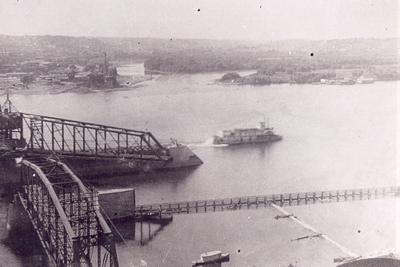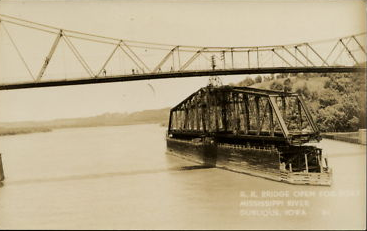Encyclopedia Dubuque
"Encyclopedia Dubuque is the online authority for all things Dubuque, written by the people who know the city best.”
Marshall Cohen—researcher and producer, CNN
Affiliated with the Local History Network of the State Historical Society of Iowa, and the Iowa Museum Association.
DUNLEITH AND DUBUQUE BRIDGE
DUNLEITH AND DUBUQUE BRIDGE. Construction project, also known as the Railroad Bridge, across the MISSISSIPPI RIVER in the late 1800s. Prior to the construction of the bridge, railroad cars, wagons, and travelers of the 1860s had to be carried across the Mississippi on FERRYBOATS.
Hopes for a bridge across the Mississippi River began in 1860 with a Congressional land grant to the Illinois Central Railroad on the condition that it extend its line to Dubuque. No action was taken on this project until 1866 when a meeting of prominent Dubuque residents was held at the Julien Hall. A plan was proposed and a company organized, but again no action took place.
It was not until 1867 that the Dunleith and Dubuque Bridge Company was organized. The first board of directors included William Boyd ALLISON, president; Henry L. STOUT, vice-president and treasurer; and Platt SMITH as one of the directors. All stock in the company was purchased in Dubuque, Boston, and New York.
When the company made application to the City of Dubuque to locate the western end of the bridge and gain right-of-way into the city, many citizens argued that the bridge should also offer a wagon-way. The Council refused to be delayed by these requests, however, and construction contracts were arranged.
Andrew CARNEGIE of the Union Iron Mills and the Keystone Bridge Company of Philadelphia eventually won the contract. Work began on a bridge 1,760 feet long with seven spans and a 360-foot draw span that allowed river traffic to pass under the bridge.
A tunnel, blasted through the East Dubuque cliffs provided an approach to the bridge, and rock from the tunnel was used for bridge supports. Pilings for the bridge were driven through the ICE and into the streambed. The tunnel and bridge were completed in December 1868, one month ahead of schedule at a cost of $800,000. The bridge was officially opened on New Year's Day, 1869.
In November 1887, it was announced that the Dubuque stockholders of the railroad bridge had sold their two-thirds interest to the Illinois Central that already owned one-third. The dual ownership had been a source of conflict. While both the Illinois Central and the stockholders had wanted other rail lines to be able to use the bridge, satisfactory terms could not be reached and other railroads were therefore shut out of Dubuque. The Illinois Central held a contract that called for an annual rental of $80,000 to be paid to the stockholders in addition to a fee for each car that crossed the bridge. The railroad, in purchasing the stockholders interest, stated its desire to lower this rate for itself as well as the other railroads that used the bridge. One immediate beneficiary of the new agreement was the Burlington and Northern Railroad that had to use a transfer boat to ferry its cars across the Mississippi.
Designed for the use of small steam engines, the bridge was never intended for heavy trains. In need of repairs by 1898, the bridge was renovated. The marsh area on the Iowa side of the bridge was filled, and the length of the bridge was shortened by 225 feet. The bridge today remains generally the same as that which resumed business by 1900. The bridge has 5 spans and a swing-span. It is currently operated by Canadian National Railway as a result of their purchase of the Illinois Central in 1999. (Photo Courtesy: http://dubuque-tour.tripod.com)





